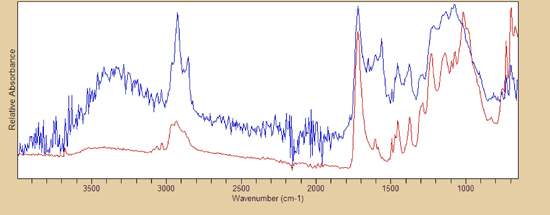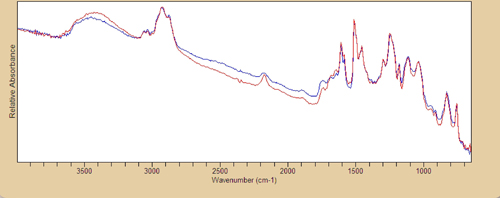FTIR Non Destructive Analysis
Fourier Transform Infrared Spectroscopy (FTIR)
Fourier Transform Infrared Spectroscopy (FTIR) is a non destructive testing method to analyse chemical functions in materials by detecting the vibrations that characterize chemical bonds; it is based on the absorption of infrared radiation by a material. A device (spectrometer) focuses infrared radiation on the sample to measure both wavelengths at which the material absorbs the radiation and the intensity of absorption. A spectrum is then produced via a mathematical operation called Fourier Transform. Spectra can provide either qualitative or quantitative information. The wavelengths absorbed by the sample are characteristic of the chemical groups present in the sample. Absorption intensity at a characteristic wavelength indicates the concentration of the chemical group responsible for the absorption.
Q.I. Composites laboratory is equipped with a portable FTIR spectrometer designed for non destructive and on-site analysis applications. Polymers, liquids, solids, gels, composites, coatings, paints can be analysed by this apparatus.
Some applications are listed:
- Measurement of composite heat damage:
thermal damage causes oxidation of resin component in composite materials, which can lead to loss of strength of the composite part. FTIR spectroscopy can identify and quantify oxidation products and identify heat damaged areas. - Material composition verification:
thermal FTIR analysis is useful to identify paints, primers, protective coatings, plastics. Material composition of these parts can be determined by infrared spectroscopy. - Surface cleanliness verification:
Contamination present on the surface of materials to be bonded or present in the primers and coatings necessary to ensure proper bonding will significantly affect the strength and long term durability of the bond. Contaminants could be oil mists, humidity and even perspiration and fingerprint oil from human sources. All of these contaminants can affect the quality of the bonding process. FTIR analysis device can detect presence of contaminants with non destructive inspection. - Presence of contaminants:
Presence of contaminants in resins, gelcoats could lead to loss of strength or yellowing of the surfaces when exposed to UV rays. FTIR analysis device can detect presence of contaminants using non destructive inspection of material surfaces. Also, fuel or other chemicals can be absorbed into resin-fiber matrix and FTIR analysis can be used to monitor contamination of the composite as well as eventual degradation of the composite, thus providing an important tool to identify potential further damage of the composite. - Chemical degradation:
Resin composites are sensitive to heat conditions, oxidative/degradative processes such as ultraviolet radiation and exposure to chemicals. FTIR analysis can be used to measure degradation of composites due to heat, ultraviolet or chemicals.

FTIR spectra of two gelcoat samples taken from same boat:
red spectrum is white gelcoat , blue spectrum is yellowing gelcoat (originally white). Comparing both spectra with reference mixed and cured in laboratory (not available in image) we can see that both samples are contaminated by some oil and so, probably, also white sample will yellow in the future.

FTIR spectra of two carbon-epoxy samples:
red spectrum is from correct laminate, blue spectrum from same laminate exposed to heat. We can see that cross-linking was degradated by heat exposure and so resin strength characteristics are compromised.

FTIR spectra: of a reference material in polypropylene (blue) and a tube consisting of the same material (green) used in a chemical plant.
The combined action of UV light and oxygen, with time, damages polymers, leading to the degradation of the material and compromising its mechanical properties. In the specific case, comparing the two spectra it can be observed that the molecular chains of the tube material are damaged.

